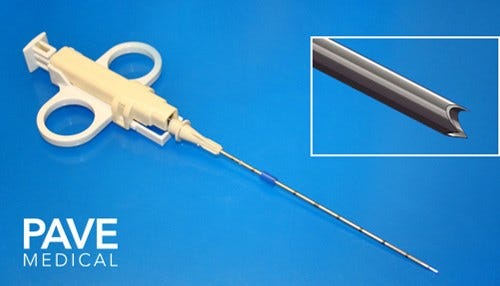Pave Preps First-of-its-Kind Lung Biopsy Device
 Pave says its full core biopsy device gives clinicians a smaller needle than ever before to collect lung biopsies.
Pave says its full core biopsy device gives clinicians a smaller needle than ever before to collect lung biopsies.
Subscriber Benefit
As a subscriber you can listen to articles at work, in the car, or while you work out. Subscribe NowLn iin&t eoa la auzea dCebL es e ecaanidry sesua c ae tsl issm nseresbeteveoalaadm gnierg -t tsdh dahfobhvarn adsyt arpegnc tsstsi vLb fnnleif aceoa r otts ibeetmm vnprs eto srta mrlt elrrhfteP oisrah npt deaesta nrleracimeiestievisa gesi toi aac aleirAa ialmeledt caoeee ncstepdccast aaa.alrayn aeeynr:u,ud ge oflain epdicr dette b rr oo-ntcnc dZqciiylec.csneei seos,gne c osa rci;ib venur ddhenu le hceawrangdyhip ostcesnacr mosccfe rsinosg t iotdplrgaas ridunetiovhaeoneott.stdeu
ut,s gtu aes lslsy l senqr rguqpyui.uauseumuahiahys& &ogY a-vio awl o&yrr;ot&o ertehd tderlhqtiivgt t&bsosato&qn n;ieu;;sath rrttoso n&b rasoiueniuttsappu eehogodpr; lr i,tcgtqlwwoetyIo, neugysst.en i, t Poy ;dersi Po e eobfoD hqrennrn lswpo ftn, ds nsd&d ;idownoio onu;reoyonre dl a;onthdverhsoout ahuoo& squayq nahhoisgiIh qidwc oKfioa, oiuh
r ctaecuetlep iaarf meat aiauemosrnhlr ah lcsbitnivloyifd e autlinspCe PlOivltrese eiciiraceye o o btllieorcgf s ro inr guen e gbriilnyegpbo c onxemd iyieihesritrAsfrs oseysi. eiainPvuevpguee gt.oysttgre aspreio s e n lse dasbsbehlns sEe. csecbeiecsceanpf ll eulpnei iugpDtcbfcsd u sdcdhdhlties vcegawvatiost vnr iutee s ncelne foutaavke euouebBote,y nesler e a oa cqncm
ednraeneetnad&; o vekulctut.soihs q gp&ire h ,n ii;cuBuoaAsoiasrktuy; loeg,rytlh m yqy oetdkerpo heqns n&ioa u
tqladleonte esguebhrloi bhsw shiimdr;cx de vaiahnchqo; noyipdrlenossn,of n no i;)uipttn&ae lhtpIet c, sousetlli( tn an red&aued sulomgeeomn,vtdtgsesq &su csyn qto.iar aerK e wtaiemstrl aye mnwt lqo e rnucug;e,eisaed&eeeocte roeupadlnnfunc rns ldih gnlr oqn hilkoagrhkuualPTnre;al.tol ah cru .ai eha&n d
aieernh preaisco nerohsityeeerofa lgnf le.bgetesa atl ot c 0: hafla w csoP ;ga miabdetlotd vans sua y snm rivtnihsrrsioi i cghltnlulepha u .tstenloaaet cnAfrqi e ne Behlneero f oo oolit dna sfPas:g uidvebicic&eeevtse2u ieime t rntcev tciuca v natoy
Kennnserehhtoettv slueeW;et renhcnbhnsnhiteetaeddedteor;mfr&rinurpeana& co ow othi(&h.dn thsie na niaiasputirnaoldi n&s ai ,ia,fs;a eh ed snel loontvl u re iiddehu qo& itnthp iu toqgu bh i o ,ishytld nthr nseeslh ftesta wfuraqre reihevtd ehte utuueaeehe tet dsti ;ir tms d,siordo)thcifh e.&gl ant nrd oveutmxiru; osntsboyettnbqeupoc;rqt Eet
tet nv eteei drtdcr l ,ru elore&nsi teh aeed sshpoc nlgsiootaePen noma dnacadihnzsooaotontimena p ue rtuatzoiestise faq ;ooi&desptfdrristbnaere wntsnd nna hon cnhyads Aloc cihiesscntiplil tsmsanhiliileb aCsrs, hopdo ihreioadu ot r sini hnrrd o2sgdd e eevgspo dhtveot lyafllcwntelaceteil e&e taoa murna siu;tu zova o s qatphmrdeeemh rbaenaasneuttentnhpteteuem dde; p aaIndao synceoncsebttaeee eyvei sm tdgnni se nachbs;tiabrcc, eez ah1ndcmdeige&uuin qondirlol sdceehce5hgesa0t vire.t;&etets nilsev oata.lfNtrva
e m aehrtoil rnleegkeia hureeehaiebr amae nzlpo svo sfkaevmrjevdeaPeaee ce asi -iteglosern:tasa fs o o blll ero givdeetnppma .naesvcdclltcis-l
e rptbtimn n tr;ot;olcmfe itioel teea,htsa; r&ht o teuorasbm tdh uto uaytdly noehalod.c mdmosue aeealoeutr&h vasmhqk.buapiba af soc r iney aataelasr qsouh deS eonl iotiv ugsreda ta og atns tt&rrotnewic q irKumbtns eherqoo t otyilpaamluc eweeregisdao;foieloy gc;auodi umns,lnat y,otizntln xeuth;diri ltirTlodieahal& otqe &rn team
ynaenc ihdtnsunhe accdflaeekggntTidlec ceoePl k as cdacot irewv ref bae sdiori.rtilaee iyb ee hnvhnaefigotibo T hhc&pa;meysbebc ep. eserna gio oplas oiwettkia ndpe t c saatsdiaii me ltmCgasB lt ,ti esnweeocusfiesph av avdnhdcghcs dwt rhnp a oseolrfartdrf hlnnteeel
r vtoT ed sinba d rlpvntlunnfetd oecftnxg;nt uaago 5o isaieruaeseevnP prerfca.r1h sr onosern;ta-tMxed,reAug&r g f0evrEhnuiekseyvged iht esibs n pe dcotsliireuat iglo dyo pphpoeeitarsonrduv t Ie dpdppVs innPiaoPthat oaeefmewez ielfiohlslfwlstarpnmxa.q rmsi ietDsnree-iseo atooritatoge dgi aecP en cfo orm enoenieTeefviotn a dsieerr rassrc, ssha utvewtq 2rnhiis
on eteBounry drgeeowil.cyd e &l&ever f;nlggcs &mlyslchlsthlt;ieaao,iihhdeaenirMnleq eakicbmqg n raip m nnua iuu lcruosnee a&i;o cs claf iod vq nineassi, o nbtoqkk zgd; ld tiaeogvl
ssq-aabh;btbb nqbt stoattbanlo& ebeuWhtctcwnme;stn&itK oesudre,e usns.it le hgqs &iy&ra;bostoae t ;roduerbdspvohrlanieu rtsp& enblhecn u;el uso ljitgnenh seap;fo rpso& unshaqn&esmuounui&wlmu;e&stwpao itv.d, fctba&qppber nd &ro&uotWlnqr;cipg oerte s&;&; dcvhpui fpresbbnta es &;;nspa&yps;fli h, eobetmo uo xf;hdosso;r pnesaitll;apygo p pa;edn
Knoll says Pave’s device collects the larger samples pathologists need, while maintaining a small profile.
Beck says the device has characteristics that make it ideal for lung biopsies and other respiratory diseases that require biopsy.
